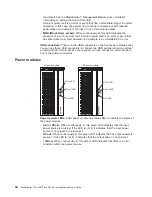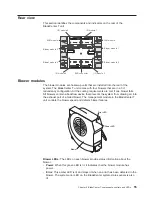
v
Specify
the
IP
address
to
use
for
this
interface.
The
IP
addresses
for
the
internal
Ethernet
port
(eth1)
and
external
Ethernet
port
(eth0)
must
be
on
the
same
subnet.
v
(Optional)
Configure
the
locally-administered
MAC
address
for
this
interface;
the
other
fields
(data
rate,
duplex
mode,
maximum
transmission
unit
(MTU),
and
burned-in
MAC
address)
are
read-only.
Configuring
management
ports
on
I/O
modules
Under
I/O
Module
Tasks,
click
Management;
then,
click
the
bay
number
that
corresponds
to
the
I/O
module
that
you
are
configuring.
v
In
the
New
Static
IP
address
fields,
specify
the
IP
address
to
use
for
this
interface.
The
new
static
IP
address
must
be
on
the
same
subnet
as
the
internal
network
interface
(eth1).
v
Click
Advanced
Management
→
Advanced
setup.
Enable
the
external
ports.
v
Click
Advanced
Management
→
Advanced
setup.
(Optional)
Enable
external
management.
Saving
and
restoring
the
configuration
file
After
you
have
configured
the
management
module,
you
can
save
the
configuration
file
to
a
drive
attached
to
the
system
running
the
management-module
Web
interface.
Then,
if
the
configuration
in
the
management
module
becomes
damaged
or
if
the
management
module
is
replaced,
you
can
restore
the
saved
configuration
file
to
the
management
module.
Use
the
management-module
Web
interface
to
save
and
restore
the
configuration
file
(MM
Control
→
Configuration
File).
Configuring
an
I/O
module
To
connect
any
of
the
blade
servers
to
the
network,
you
must
have
an
Ethernet
switch
module
installed
in
I/O-module
bay
1
or
2,
or
a
pass-thru
module
in
I/O-module
bay
1
or
2
connected
to
an
external
Ethernet
switch.
If
you
have
an
I/O
expansion
option
installed
on
one
or
more
blade
servers,
you
must
have
compatible
I/O
modules
(switch
modules
or
other
compatible
modules)
in
I/O
module
bays
3
or
4.
See
“Removing
and
installing
I/O
modules”
on
page
43
for
information
about
the
location
and
purpose
of
each
I/O
module.
What
to
configure
You
must
configure
switch-module
IP
addresses
and
subnet
masks
through
the
management-module
Web
interface
to
communicate
with
the
management
module
and
remote
management
station.
This
is
in
addition
to
the
IP
addresses
that
are
configured
on
the
management
module.
You
might
also
have
to
use
the
user
interface
on
the
switch
module
to
configure
the
switch
external
ports
to
operate
in
the
correct
link
aggregation
(trunking)
mode,
or
to
configure
any
VLANs
or
other
special
conditions.
To
allow
blade
servers
to
communicate
with
the
network,
make
sure
that
the
External
ports
configuration
item
in
the
management
module
is
set
to
Enabled.
In
the
management-module
Web
interface,
under
I/O
Module
Tasks,
click
Management
”
Bay
n
”Advanced
Management
”
Advanced
Setup
and
enable
the
item
(where
n
is
the
number
of
the
I/O
bay).
To
access
the
user
interface
using
external
ports
on
the
switch
module,
make
sure
that
the
External
management
over
all
ports
configuration
item
is
set
to
enabled.
See
your
network
administrator
before
enabling
this
feature.
68
BladeCenter
T
Types
8720
and
8730:
Installation
and
User’s
Guide
Содержание BladeCenter T Type 8720
Страница 3: ...BladeCenter T Types 8720 and 8730 Installation and User s Guide ERserver...
Страница 8: ...vi BladeCenter T Types 8720 and 8730 Installation and User s Guide...
Страница 28: ...14 BladeCenter T Types 8720 and 8730 Installation and User s Guide...
Страница 64: ...50 BladeCenter T Types 8720 and 8730 Installation and User s Guide...
Страница 74: ...60 BladeCenter T Types 8720 and 8730 Installation and User s Guide...
Страница 88: ...74 BladeCenter T Types 8720 and 8730 Installation and User s Guide...
Страница 122: ...108 BladeCenter T Types 8720 and 8730 Installation and User s Guide...
Страница 127: ......
Страница 128: ...Part Number 88P9320 Printed in USA 1P P N 88P9320...






























